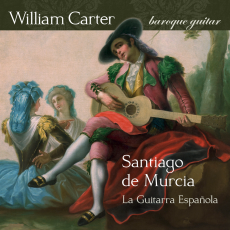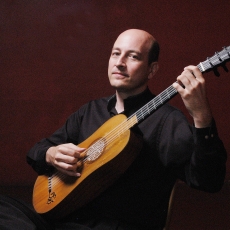Santiago de Murcia - William Carter - MusicWeb-International
A richly enjoyable recital, which deserves to win a high place in the canon of baroque guitar CDs.
Santiago de Murcia's compositions are central to such knowledge as we can have of the Spanish guitar repertoire in the baroque era. Sadly, only a small proportion of the extensive repertoire for the instrument by Spanish composers in the seventeenth and early eighteenth centuries seems ever to have been written down. Judged on the evidence of what survives, de Murcia might reasonably be thought to mark a culmination of one phase of the instrument's history in Spain. His work has been the subject of considerable study in recent decades and, excitingly, new sources of his music continue to be discovered. In the May 2007 issue of Early Music (Vol.XXIV. no.2) Alejandro Vera reports describes the discovery of a new manuscript, dated 1722 and entitled Cifras Selectas de Guitarra (in Chile). This can be added to the three existing sources: the Resumen de acompañar la parte con la guitarra, published in 1714, the 1732 manuscript entitled ‘Passacalles y obras de guitarra' (discovered in Mexico and now in the British Library, Add. Ms. 31640) and the undated manuscript collection known as ‘Códice Saldívar no. 4', discovered in Leon in Mexico in 1943 - William Carter's excellent booklet notes refer to this discovery in passing.
Hard facts on Santiago de Murcia's life are not abundant. He was presumably related to the Gabriel de Murcia who was the Queen's maker of guitars in Madrid towards the end of the seventeenth century (perhaps Gabriel was his father). He was presumably also related to Antonio de Murcia, active in the musical life of the royal court until his death in 1709. Santiago himself was, at one point, in the service of the Italian nobleman Jacome Francisco Andriani in Madrid; in the Resumen he is said to be "Guitar Master to the Queen, Our Lady, Maria Luisa Gabriela of Savoy". Perhaps he spent time, in later years, in the New World - though there is no conclusive proof of this.
The music of Santiago draws on, and makes an impressive fusion of, a variety of musical traditions. He was, naturally, familiar with the Spanish guitar tradition, as embodied in, for example, the work of Francisco Guerau and Gaspar Sanz; he was familiar with the work of important foreign composers, such as Corbetta and Corelli; he responds, to and adapts, the popular dance music of Spain and its colonies. All of these elements are audible in this present recital. The passacalles follow the theme and variation pattern typical of Spanish guitar music; in the ‘Preludio Grabe de Coreli' and the ‘Giga de Coreli', we have attractive transcriptions of the first and last movements of Corelli's Violin Sonata Op.5, no.3; in the ‘Zarambecques' and the ‘Cumbees' we have versions of dances which are West African in origin, but may have found their way to Spain via the American colonies. As scored by de Murcia, and played by Carter, these are infectiously sensuous dances, earthy and yet paradoxically refined. It all makes for a mixture both heady and subtle, for music that is both delicate and passionate, without ever being merely rhetorical or overstated.
In his recital William Carter plays a 1991 copy of a guitar by "Sellas" (presumably Matteo Sellas or another member of the Venetian family of instrument makers). It has a bright but intimate sound, capable both of an attractive resonance and a winning delicacy. Carter's own playing is both relaxed and precise, seductive and scholarly and it benefits from a recorded sound of exemplary quality.

